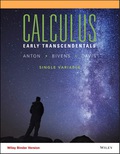
Concept explainers
Solve for x and y in terms of
Want to see the full answer?
Check out a sample textbook solution
Chapter 14 Solutions
EBK CALCULUS EARLY TRANSCENDENTALS SING
Additional Math Textbook Solutions
Elementary Statistics Using The Ti-83/84 Plus Calculator, Books A La Carte Edition (5th Edition)
Elementary Statistics (13th Edition)
University Calculus: Early Transcendentals (4th Edition)
Algebra and Trigonometry (6th Edition)
- Q7. a) Consider the vectors u , v and w are defined by u = i+j ,v= i + 4j and w = 4i – 3j i. If the initial point of v is (1,3), then find the terminal point of v. ii. u·w b) Find parametric equations for the line l passing through the two points A ( 1, 0, –3 ) and B ( 2, –1,4).arrow_forwardIdentify the center and radius for each. r? + y? = 49 x² + y? = 324 x² + (y + 2) = 64 (r + 2)² + y² = 64 (1 – 5)² + (y – 3)² = 144 (z+1) + (y – 10)? = 100 :: Center: (0, 2), r = 8 : Center (-1, 10), r = 10 : Center: (-2, 0), r = 8 :: Center: (1, – 10), r = 10 :: Center: (0, 0), r = 18 : Center: (5, 3), r = 12 : Center: (2, 0),r = 8 : Center. (0, 0), r = 7 : Center (-5,-3), r = 12 : Center (0, -2), r = 8arrow_forwardboth a and barrow_forward
- Find u x v. u = (1, -2, 0), v = (1, 0, −1) Show that ux v is orthogonal to both u and v. (u x V) u L Bemut (u x V) v =arrow_forwardEngineer math Determine the Partial Derivatives of the following Vectors with respect to x, y, and zarrow_forwardthe vectors №₁, №₂, Y3 (where y; € R² V i) must be linearly dependent?arrow_forward
- Eliminate the parameter: I=e+t,y= e -tarrow_forward4. Given that the Cartesian equations of line L is y = 3, x + 2 =z. A(2,1,0) and B(1,4,5) are two points outside the line L. N is a point on line L such that AN is perpendicular to L. (a) State the parametric and vector equations of L. (b) Find the coordinates of N. (c) Find the acute angle between line BN and L.arrow_forwardWhich of the vector functions below represents the curve of intersection of the following two surfaces: x² +4y²+4z² = 16 and y = x². Select one: ○ a. r (t) = (t, t², O b. r (t) = (t, t², |○ c. r (t) = (t, t₁, ○ d. r (t) = t, -t² = (t, 16++²-4+4 4 1 16-12-4t 4 O e. None of the above ○ f. r (t) = (t, t², √ 16-12+4t 4 16-12-4t 4 4-12-4t4 4arrow_forward
- Let u=⟨4,1,5⟩, v=⟨2,1,3⟩ and w=⟨−a,2,a⟩. (b) Find value(s) of a for which the angle between 2u−3v and w is 2π/3.arrow_forwardPlease help me solve, thank you. Don't reject my question. I just want to learn. It's my year one linear algebra question.arrow_forwardLet A(5, –1, –3) and B(1, 3, 2) be two points in R. The directional derivative of f(x, y, z) = xy + 11yz + 7zx at the point A in the direction of the vector AB is Use calculator and write your answer in three decimal digits, like 34.123arrow_forward
 Elementary Linear Algebra (MindTap Course List)AlgebraISBN:9781305658004Author:Ron LarsonPublisher:Cengage Learning
Elementary Linear Algebra (MindTap Course List)AlgebraISBN:9781305658004Author:Ron LarsonPublisher:Cengage Learning Elementary Geometry For College Students, 7eGeometryISBN:9781337614085Author:Alexander, Daniel C.; Koeberlein, Geralyn M.Publisher:Cengage,Algebra & Trigonometry with Analytic GeometryAlgebraISBN:9781133382119Author:SwokowskiPublisher:Cengage
Elementary Geometry For College Students, 7eGeometryISBN:9781337614085Author:Alexander, Daniel C.; Koeberlein, Geralyn M.Publisher:Cengage,Algebra & Trigonometry with Analytic GeometryAlgebraISBN:9781133382119Author:SwokowskiPublisher:Cengage


